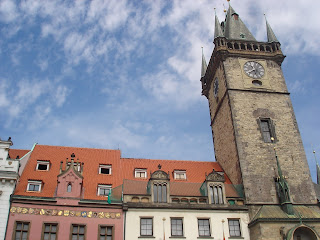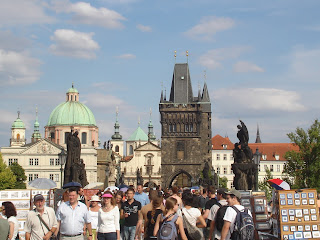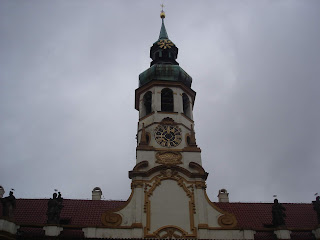Prague, the capital of the Czech Republic and a city with a population of over 1.2 million, is one of the prettiest cities in Europe. I went there on a school trip as a kid in the mid eighties, and then I went and spent three days there in 2008. I was totally taken in by the beauty of the medieval old town square, and all the landmarks that are dotted along it.
 |
| Old Town Square with the Old Town Hall |
Prague became one of Europe's most important capital cities in the 14th century under the rule of the Holy Roman Emperor, Charles IV, who was the king of Bohemia. The city prospered under him and saw a lot of development. In the 16th century, Prague came under the rule of the Austrian Habsburg empire and became one of its most important centres. The end of World War I saw the death of the Habsburg empire and Czechoslovakia was formed, with Prague as its capital. In 1993, Czechoslovakia split up into the Czech Republic and Slovakia, and Prague became the capital of the Czech Republic.
The
Old Town Square lies in the heart of the city, and has several of the city's best known landmarks around it. It also has numerous high end shops, restaurants and cafes. In the centre of the square, there's the
Jan Huus Monument, erected in 1915 to commemorate the 500th anniversary of his burning at the stake. He was a rebel leader who fought against the corrupt practices of the Catholic State. The
Old Town Hall was built in the 14th century. It is 69 meters tall and has a viewing gallery at the top. The building has an astronomical clock with mechanical figures that perform with a set frequency. The
Church of Our Lady of Tynn has two distinct spires. The church dates back to the 14th century and became a Jesuit church in the 17th century. It has a rich, baroque interior.
Kinsky Palace on Old Town Square was built in 1765. It was built by the Golz family and then bought by the Kinsky noble family, and hence the name. It is now an art museum. I found myself spending almost a full day at the Old Town Square, between seeing the various sights, having a leisurely lunch sitting at one of the many outdoor cafes, and window shopping at the fancy shops around.
 |
| Jan Huus Monument |
 |
| Church of Our Lady of Tynn |
 |
Church of Our Lady of Tynn,
View from Old Town Hall |
 |
| Old Town Hall |
 |
| Kinsky Palace, Old Town Square |
The Old Town Square also boasts of the
Church of St Nicholas, which has a large green dome and two bell towers. It also has a large chandelier inside. The church was completed in 1737.
 |
| Church of St Nicholas, Old Town |
 |
Church of St Nicholas,
View from Old Town Hall |
 |
| Church of St Nicholas, Old Town |
Powder Tower is one of the original city gates dating back to the 15th century. It separates the Old Town and the New Town. In the 17th century, the tower was used to store gunpowder, and hence the name.
 |
| Powder Tower |
There is also the
Church of St Nicholas in the Lesser Town, completed in 1755. It is a richly decorated baroque church, with a 70 meter high dome.
 |
| Church of St Nicholas, Lesser Town |
|
|
Dome Interior, Church of St Nicholas, Lesser Town
|
 |
Crucifixion, Church of St Nicholas,
Lesser Town |
 |
St Cyril, Church of St Nicholas,
Lesser Town |
The
Church of Our Lady of the Snows was founded in the 14th century but construction was greatly delayed because of a paucity of funds. The church was completed and modified in the 17th century.
 |
| Church of Our Lady of the Snows |
 |
| High Altar, Church of Our Lady of the Snows |
Charles Bridge is one of the most famous and beautiful bridges in the world. The magnificent bridge dates back to the 14th century and was built under the reign of King Charles IV after the Judith Bridge was destroyed by floods. The 621 meter long bridge is lined with a series of 30 baroque sculptures, including those of the Pieta, the Crucifixion of Christ, St John of Nepomuk and St John the Baptist. The bridge has beautiful gothic bridge towers at either end. Until 1841, the bridge was the only way of crossing the river Vltava, with the old town on one side and Prague Castle on the other side.
 |
| Crucifixion statue on Charles Bridge |
 |
Charles Bridge, with the bridge tower
towards the Old Town Square |
 |
Charles Bridge, with the bridge tower
towards the Little Quarter |
The
Jewish Town Hall was constructed in 1586. It was given a rococo exterior in the 18th century. It has two clocks, one with Roman numerals, one with Hebrew numerals.
 |
| Jewish Town Hall |
Prague Castle is situated on a hill, and is visible from many parts of the city. The castle dates back to the 9th century, and since 1918, it has housed the office of the President. The castle's best known landmark is the
St Vitus Cathedral, with its two distinctive steeples, its large Rose Window and the tomb of King Wenceslas. Nearby, there's the
St George Basilica, dating back to the 10th century. The basilica was built by Prince Vratislav, and his tomb lies inside.
 |
View of Prague Castle and St Vitus Cathedral,
seen from Charles Bridge |
 |
| St George Basilica at Prague Castle |
The
National Museum lies on Wenceslas Square. It was built in 1890 and has a grand renaissance exterior. The collections inside include sections on natural history, mineralogy, archaeology, anthropology and numismatics.
Wenceslas Square, on which the museum stands, was originally a horse market. It was the spot where the student leader Jan Palach immolated himself in 1969 to protest against the Soviet invasion. It was also the site of the Velvet Revolution in 1989, which eventually saw the end of Communist rule. The square has a large equestrian statue of St Wenceslas.
 |
| National Museum at Wenceslas Square |
 |
| Statue of St Wenceslas at Wenceslas Square |
 |
| Wenceslas Square |
 |
| Grand Hotel Europa, Wencaslas Square |
Wallenstein Palace was built in 1630 by Albrecht von Wallenstein. Emperor Ferdinand II had Wallenstein assassinated in 1634, but the palace remained with the family till 1945. Now the Senate of the Cech Republic operates from here.
 |
Venus and Adonis Statue,
Wallenstein Palace |
Strahov Monastery is a 12th century abbey built by Jindrich Zdik, Bishop of Prague. The monastery has an impressive library called the Philosophical Hall, and a picture gallery.
 |
| Stahovsky Monastery |
Loyola Church is also known as St Ignatius Church. The baroque church was completed in 1677. It was built for the city's Jesuits.
 |
| Loyola Church |
Dancing House was completed in 1996. The building is also known as Fred and Ginger, after the American dancers Fred Astaire and Ginger Rogers. The building was very controversial because of its non traditional design, in an otherwise traditional city with baroque, gothic and art nouveau architecture.
 |
| Dancing House |
Three days weren't quite enough to explore the many sights of the city, and I would have been happy if I had got another day or two. I left the city fully convinced that I had seen one of the most beautiful cities in Europe. While in Prague, I caught up with a friend I had recently been introduced to. She was a wonderful, pleasant mannered person and the idea was for us to get to know each other better, but knowing the way I am when it comes to travel and exploring places, I wasn't able to spend much time with her at all. I'm sure she wasn't happy about that, but put me in a new city (that too a city as splendid as Prague), give me a camera, and I'll drive myself crazy trying to explore every nick and corner of the city, neglecting much else along the way!!






























2 comments:
Very well written and informative
Thank you!
Post a Comment